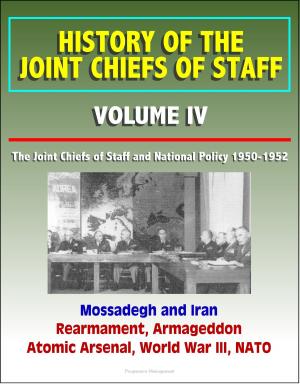Trinity: The World's First Atomic Explosion - History of the Atomic Bomb Test and the New Mexico Test Site, Rehearsal Shot, Report on Nuclear Energy Released, Damage Effects, Observations
Nonfiction, History, Military, Nuclear Warfare| Author: | Progressive Management | ISBN: | 9781301419371 |
| Publisher: | Progressive Management | Publication: | March 19, 2013 |
| Imprint: | Smashwords Edition | Language: | English |
| Author: | Progressive Management |
| ISBN: | 9781301419371 |
| Publisher: | Progressive Management |
| Publication: | March 19, 2013 |
| Imprint: | Smashwords Edition |
| Language: | English |
The history of the world's first atomic explosion on July 16, 1945 at the Trinity test site in southern New Mexico is covered in this unique compilation of reports and publications. The report of the Los Alamos Scientific Laboratory provides a comprehensive record of the atom bomb test; other publications reveal secrets of the test site.
The introduction of the report states: Preparations for the Trinity test were started in March 1944 and culminated in a 100-ton rehearsal shot on May 7, 1945 and the final gadget test shot on July 16, 1945. The purposes of this report are: To put on record the development, scope, and type of operations involved in the July 16, 1945 atomic bomb test with recommendations for future operating procedure; to collect in one place all the reports relating to the apparatus and results, planning, and administration. A test of the atomic bomb was considered essential by the Director and most of the group and division leaders of the Laboratory because of the enormous step from the differential and integral experiments, and theory, to a practical gadget. No one was content that the first trial of a Fat Man (F.M.) gadget should be over enemy territory, where, if the gadget failed, the surprise factor would be lost and the enemy might be presented with a large amount of active material in recoverable form. The only thing that could finally settle the many questions current before the test was an actual experiment with full instrumentation. Plans were made for yields from 100-10000 tons with the most probable value 4000 tons (July 10, 1945). The safety of personnel and structures was insured for yields as great as 200000 tons. The final functioning of the bomb showed that the prior work had been excellent in every respect and no vital factor had been overlooked... In the winter and spring of 1944, the possibility that the first test bomb would not work at all was constantly in mind. Discussions had been held between S. Neddermeyer, G. B. Kistiakowsky, J. R. Oppenheimer, and others to consider the construction of a large pressure vessel that would be able to contain the active material and products of the explosion of a high explosive, if the operation of the first atomic bomb should be a complete fizzle. The need for the containing vessel was based on the uncertainties of the behaviour of the bomb and the desirability of conserving active material.
Contents include: CALIBRATION AND REHEARSAL SHOT * Plan and Organization * Firing of 100-Ton Shot * Results of the 100-Ton Shot * Report on First Trinity Test * Purpose of Test * General Character of the Test * Program of Measurement and Observation * Organization for Carrying Out the Program * Behaviour of the Implosion * Nuclear Energy Released * Damage Effects Produced * Overall Behaviour of the Explosion and Its After Effects * Meteorological Observations * Health Control * Conclusion * Post 100-Ton, Suggestions For Improved Facilities and Procedure: Suggestions for Improvements * Conclusions Concerning the 100-Ton Test * PREPARATIONS FOR THE JULY 16 TEST * Coordination of Preparations * Consultants * Weekly Meetings * Acceptance of New Experiments * Prompt Dissemination of General Information * Coordination of Construction * FINAL PREPARATIONS FOR REHEARSALS AND TEST * Schedule * Timing and Wiring Layout — Electronics * Shelter Chiefs * Arming Party * Location and Time of Shot * Protection Against Radiation — Base Camp * Directions * Health and Monitoring Organization and Preparations * Introduction * Organization of Medical Group (TR-7) * Equipment of Medical Group * Plans for Monitoring — Before Shot * Plans for Monitoring — Time of Shot * Plans for Monitoring — After Shot * Immediate Hazards * Delayed Hazards * Meteorology * WORK PRECEDING AND INCLUDING ASSEMBLY AT TRINITY * Preliminary Tests * Preparations at Y * Procedure for Final Assembly
The history of the world's first atomic explosion on July 16, 1945 at the Trinity test site in southern New Mexico is covered in this unique compilation of reports and publications. The report of the Los Alamos Scientific Laboratory provides a comprehensive record of the atom bomb test; other publications reveal secrets of the test site.
The introduction of the report states: Preparations for the Trinity test were started in March 1944 and culminated in a 100-ton rehearsal shot on May 7, 1945 and the final gadget test shot on July 16, 1945. The purposes of this report are: To put on record the development, scope, and type of operations involved in the July 16, 1945 atomic bomb test with recommendations for future operating procedure; to collect in one place all the reports relating to the apparatus and results, planning, and administration. A test of the atomic bomb was considered essential by the Director and most of the group and division leaders of the Laboratory because of the enormous step from the differential and integral experiments, and theory, to a practical gadget. No one was content that the first trial of a Fat Man (F.M.) gadget should be over enemy territory, where, if the gadget failed, the surprise factor would be lost and the enemy might be presented with a large amount of active material in recoverable form. The only thing that could finally settle the many questions current before the test was an actual experiment with full instrumentation. Plans were made for yields from 100-10000 tons with the most probable value 4000 tons (July 10, 1945). The safety of personnel and structures was insured for yields as great as 200000 tons. The final functioning of the bomb showed that the prior work had been excellent in every respect and no vital factor had been overlooked... In the winter and spring of 1944, the possibility that the first test bomb would not work at all was constantly in mind. Discussions had been held between S. Neddermeyer, G. B. Kistiakowsky, J. R. Oppenheimer, and others to consider the construction of a large pressure vessel that would be able to contain the active material and products of the explosion of a high explosive, if the operation of the first atomic bomb should be a complete fizzle. The need for the containing vessel was based on the uncertainties of the behaviour of the bomb and the desirability of conserving active material.
Contents include: CALIBRATION AND REHEARSAL SHOT * Plan and Organization * Firing of 100-Ton Shot * Results of the 100-Ton Shot * Report on First Trinity Test * Purpose of Test * General Character of the Test * Program of Measurement and Observation * Organization for Carrying Out the Program * Behaviour of the Implosion * Nuclear Energy Released * Damage Effects Produced * Overall Behaviour of the Explosion and Its After Effects * Meteorological Observations * Health Control * Conclusion * Post 100-Ton, Suggestions For Improved Facilities and Procedure: Suggestions for Improvements * Conclusions Concerning the 100-Ton Test * PREPARATIONS FOR THE JULY 16 TEST * Coordination of Preparations * Consultants * Weekly Meetings * Acceptance of New Experiments * Prompt Dissemination of General Information * Coordination of Construction * FINAL PREPARATIONS FOR REHEARSALS AND TEST * Schedule * Timing and Wiring Layout — Electronics * Shelter Chiefs * Arming Party * Location and Time of Shot * Protection Against Radiation — Base Camp * Directions * Health and Monitoring Organization and Preparations * Introduction * Organization of Medical Group (TR-7) * Equipment of Medical Group * Plans for Monitoring — Before Shot * Plans for Monitoring — Time of Shot * Plans for Monitoring — After Shot * Immediate Hazards * Delayed Hazards * Meteorology * WORK PRECEDING AND INCLUDING ASSEMBLY AT TRINITY * Preliminary Tests * Preparations at Y * Procedure for Final Assembly















